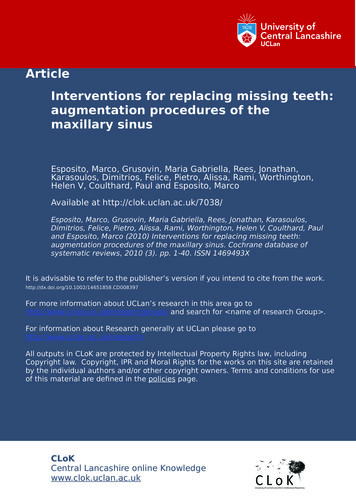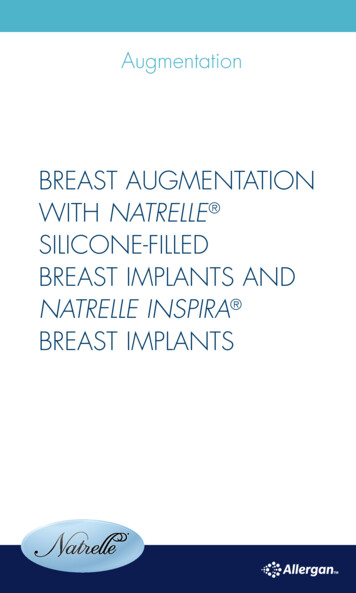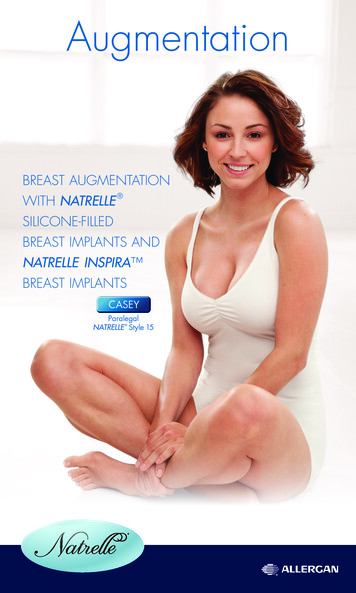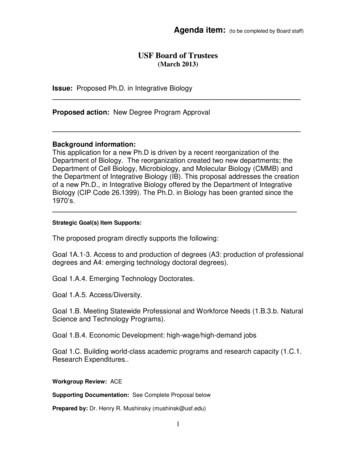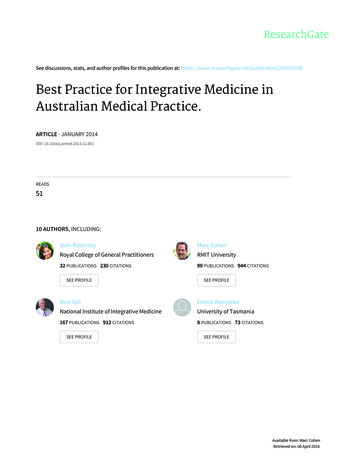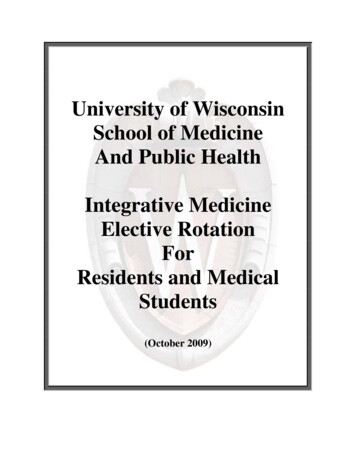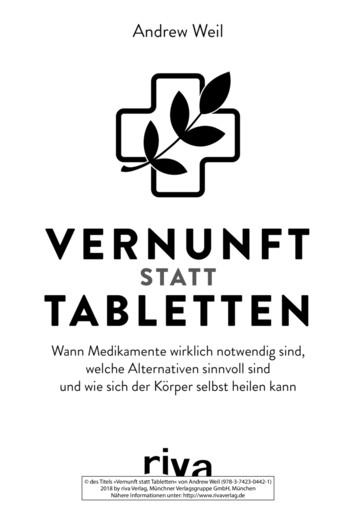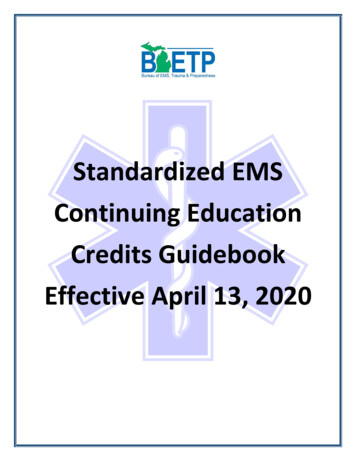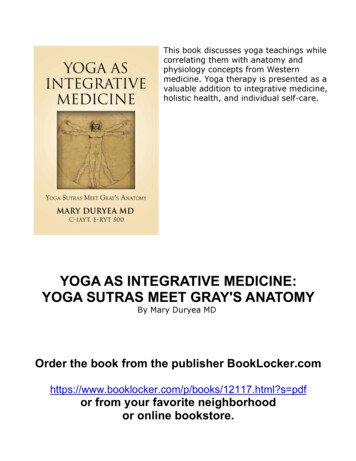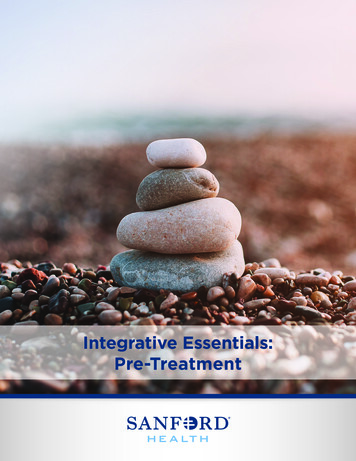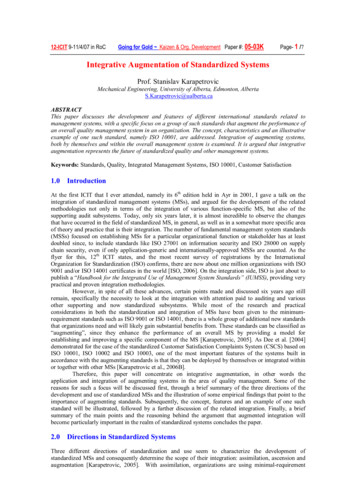
Transcription
12-ICIT 9-11/4/07 in RoCGoing for Gold Kaizen & Org. Development Paper #: 05-03KPage- 1 /7Integrative Augmentation of Standardized SystemsProf. Stanislav KarapetrovicMechanical Engineering, University of Alberta, Edmonton, AlbertaS.Karapetrovic@ualberta.caABSTRACTThis paper discusses the development and features of different international standards related tomanagement systems, with a specific focus on a group of such standards that augment the performance ofan overall quality management system in an organization. The concept, characteristics and an illustrativeexample of one such standard, namely ISO 10001, are addressed. Integration of augmenting systems,both by themselves and within the overall management system is examined. It is argued that integrativeaugmentation represents the future of standardized quality and other management systems.Keywords: Standards, Quality, Integrated Management Systems, ISO 10001, Customer Satisfaction1.0IntroductionAt the first ICIT that I ever attended, namely its 6th edition held in Ayr in 2001, I gave a talk on theintegration of standardized management systems (MSs), and argued for the development of the relatedmethodologies not only in terms of the integration of various function-specific MS, but also of thesupporting audit subsystems. Today, only six years later, it is almost incredible to observe the changesthat have occurred in the field of standardized MS, in general, as well as in a somewhat more specific areaof theory and practice that is their integration. The number of fundamental management system standards(MSSs) focused on establishing MSs for a particular organizational function or stakeholder has at leastdoubled since, to include standards like ISO 27001 on information security and ISO 28000 on supplychain security, even if only application-generic and internationally-approved MSSs are counted. As theflyer for this, 12th ICIT states, and the most recent survey of registrations by the InternationalOrganization for Standardization (ISO) confirms, there are now about one million organizations with ISO9001 and/or ISO 14001 certificates in the world [ISO, 2006]. On the integration side, ISO is just about topublish a “Handbook for the Integrated Use of Management System Standards” (IUMSS), providing verypractical and proven integration methodologies.However, in spite of all these advances, certain points made and discussed six years ago stillremain, specifically the necessity to look at the integration with attention paid to auditing and variousother supporting and now standardized subsystems. While most of the research and practicalconsiderations in both the standardization and integration of MSs have been given to the minimumrequirement standards such as ISO 9001 or ISO 14001, there is a whole group of additional new standardsthat organizations need and will likely gain substantial benefits from. These standards can be classified as“augmenting”, since they enhance the performance of an overall MS by providing a model forestablishing and improving a specific component of the MS [Karapetrovic, 2005]. As Dee et al. [2004]demonstrated for the case of the standardized Customer Satisfaction Complaints System (CSCS) based onISO 10001, ISO 10002 and ISO 10003, one of the most important features of the systems built inaccordance with the augmenting standards is that they can be deployed by themselves or integrated withinor together with other MSs [Karapetrovic et al., 2006B].Therefore, this paper will concentrate on integrative augmentation, in other words theapplication and integration of augmenting systems in the area of quality management. Some of thereasons for such a focus will be discussed first, through a brief summary of the three directions of thedevelopment and use of standardized MSs and the illustration of some empirical findings that point to theimportance of augmenting standards. Subsequently, the concept, features and an example of one suchstandard will be illustrated, followed by a further discussion of the related integration. Finally, a briefsummary of the main points and the reasoning behind the argument that augmented integration willbecome particularly important in the realm of standardized systems concludes the paper.2.0Directions in Standardized SystemsThree different directions of standardization and use seem to characterize the development ofstandardized MSs and consequently determine the scope of their integration: assimilation, ascension andaugmentation [Karapetrovic, 2005]. With assimilation, organizations are using minimal-requirement
12-ICIT 9-11/4/07 in RoCGoing for Gold Kaizen & Org. Development Paper #: 05-03KPage- 2 /7standards such as ISO 9001, ISO 14001 and ISO 27001 to establish a function- or stakeholder-specificmanagement system. Ascending standards provide additional criteria for all MS components to improvethe overall performance level of an organization, with examples including ISO 9004, ISO 14004 andvarious industry-sector-specific standards. Finally, augmentation refers to the addition or improvement ofa specific MS component, modelled in an augmenting standard such as ISO 19011 or ISO 10002. Figure1 illustrates these directions and provides examples of standards from the three corresponding categories.While these developments are thoroughly discussed from the theoretical perspective in, forinstance, Karapetrovic [2003 and 2005], it is interesting to illustrate some empirical results that point outthe need to, on one hand, focus on only two such directions in the realm of standardized MSs, and on theother, to foster augmentative integration as a methodology to capitalize on the application on thesesystems. The results are from a 2006 survey of 529 ISO 9001-registered companies in Catalonia (Spain),with the overall response rate of 23%, as detailed in Karapetrovic et al. [2006A]. One of the questions inthe survey asked the organizations’ representatives to identify the priority for future application of each ofthe three groups of standards or models in their organizations, together with an option of notimplementing any new standards or models in the future. The top part of Figure 1 shows the indicatedfirst priority responses in terms of the proportion of the total sample. Since the sample contained twostrata, namely the organizations that were registered solely to ISO 9001 (353 responding companies withthe 20% response rate) and the ones that had both the ISO 9001 and ISO 14001 certificates (176respondents and the 33% response rate), Figure 1 illustrates the results from both strata, in the inner andouter circle, respectively.As evident from Figure 1 and as discussed in Karapetrovic et al. [2006A], ISO 9001-registeredcompanies indicate the intention to use augmenting standards, examples of which are presented in bold inFigure 1, as their first priority (31%), followed by the assimilating standards (27%), while companieswith dual cross-functional certificates focus more on the assimilating standards (43%), with theaugmenting standards receiving the first priority in 22% of the responding organizations. The other twoalternatives, namely the use of business excellence models (ascension) and no new application (noaddition), received relatively low proportion of responses as the first priority. Due to the preponderance ofISO 9001-only registered companies in the overall population of organizations with standardized systems,a clear focus on augmentation and addition of new standards in general seem to characterize the futureapplication in organizations. The following section will discuss the standards underlying theaugmentation direction.3.0Augmenting Standards3.1 ConceptAlthough the need for the availability of standardized models for specific subsystems or processes of theoverall management system of an organization was evident at the time that the first management systemstandards were rolled out, for example in the 1970s and 1980s with the emergence of quality assurancestandards and ultimately ISO 9001, only recently have augmenting standards become prominent enough,both in content and numbers, to create their own distinct category [Karapetrovic and Casadesus, 2007].Basically a subset of the group of standards that support minimal, function-specific systemmodels like ISO 9001 and 14001, and that are written by the so-called “supporting” Sub-Committees (SC)within the larger Technical Committees (TC) of ISO, for example SC3 of ISO/TC176 on qualitymanagement, augmenting standards focus on a single management system component that can then beused to supplement and improve the management system itself. For example, the audit system is anessential component of any management system, and is now covered by the ISO 19011 augmentingstandard for quality and environmental management system auditing [Karapetrovic and Willborn, 2001].ISO 10002 provides a model for a complaint-handling process, which can be built, as a subsystem, into anISO 9001-based quality management system [Hughes and Karapetrovic, 2006; Dee et al., 2004].Nevertheless, unlike the other supporting standards, such as ISO 10014 on the economics ofquality and ISO 10019 on quality consultants, which can be meaningfully used only in conjunction withthe standards they actually support or the related standardized systems, augmenting standards can beapplied to establish stand-alone systems [Karapetrovic et al., 2006B]. Examples of quality managementstandards that would fit within the augmenting group include the existing ISO 10012 on measurement andthe above-mentioned ISO 10002 and ISO 19011, ISO 10001 on customer satisfaction codes of conductand ISO 10003 on dispute resolution, which will be published within the next few months, and theupcoming ISO/TS 10004 on customer satisfaction measurement and monitoring. Because of their fairlynarrow, but much focused scope, and immediately-evident benefits of implementation, augmenting
Going for Gold Kaizen & Org. Development Paper #: 05-03K12-ICIT 9-11/4/07 in RoCPage- 3 /7standards may just represent the future of standardization in quality management [Karapetrovic andCasadesus, 2007]. Additional characteristics of these standards are outlined next.ASSIMILATION27.2%EXPLANATION:Outer Circle ISO 9001 OnlyInner Circle ISO 9001 ISO 1400142.6%23.1%31.9%%ISO 27001ENSI17.9%. ASCAUGMENTATION15.3%ON22.219.9%. (NO) ADDITIONISO 14031ISO 19011ISIO00144049 0 SOIOIS 94916S/TSOISO 10001, 10002, 10003ISO 10012 ISO 1000410029Figure 1: Standardized Systems [adapted from Karapetrovic, 2005 and Karapetrovic et al., 2006B]3.2 CharacteristicsAugmenting standards (AUGS) possess a number of defining features that not only shape these standardsinto a distinctive group, but also help in determining the needs and possibilities for their futuredeployment (see Dee et al., [2004] and Karapetrovic et al. [2006B]). A list of seven such features ispresented here, together with a brief discussion of each feature.[1] AS can be applied in an independent and an integrative manner alike. An organization can,therefore, choose any augmenting standard and deploy it without ever having implemented a single otherassimilating, ascending or augmenting management system standard. It is also possible, however not
12-ICIT 9-11/4/07 in RoCGoing for Gold Kaizen & Org. Development Paper #: 05-03KPage- 4 /7necessarily desirable, for an organization that has an overall standardized management system in place,not to connect it with the system built in accordance with an augmenting standard. On the other hand,both the structure and content of augmenting standards allow for the integration of their respectivesystems with other management systems in an organization. For example, Dee et al. [2004] describe howan ISO 10002 complaint-handling system can be established as a stand-alone system, or as a subsystemwithin the CSCS and in the overall Quality Management System (QMS) based on the ISO 9001 standard.[2] AS are generic. In other words, they are universally-applicable, regardless of the industrysector or the size, location or type of the organization. This distinguishes them, for instance, from thevarious so-called “sector-specific” standards, such as ISO/TS 16949 or ISO 22000.[3] AS can be both function-specific and function-generic. For example, while the standardsfrom the CSCS series cover product-related issues and are aimed at customer satisfaction, and aretherefore focused on quality management, ISO 19011 targets the auditing of both quality andenvironmental MSs.[4] AS are system standards. They focus on establishing and connecting a set of processes thatuse various human, information, financial, infrastructure and other resources to achieve specificobjectives, by essentially providing models for the related systems. When integrated within other systems,the systems designed and implemented according to the assimilating standards become subsystems. Forinstance, audit is a system on its own, but is normally used as a subsystem of function-specific MSs andthe overall MS in an organization [Karapetrovic and Willborn, 2001].[5] AS contain all the necessary components for system establishment, including performancemeasurement through auditing. Therefore, an organization can monitor, measure and audit theperformance of a system established in accordance with an augmenting standard. These systemcomponents can either be explicitly provided for in the standard, such as in ISO 10002, which containsseparate sections on, for example, monitoring and auditing, or be implicit in the overall standardframework, such as in ISO 10001, where maintenance and improvement of the code is specificallyaddressed.[6] AS can form and be integrated within their own, and therefore unique, overall systems. Forexample, when used in combination, ISO 10001, ISO 10002 and ISO 10003 create a standardized systemaimed at customer satisfaction through codes of conduct and effective and efficient handling ofcomplaints and disputes [Dee et al., 2004]. It is possible that another customer satisfaction standardcurrently under development, namely ISO/TS 10004 on monitoring and measurement, is applied toprovide an additional component of an augmentative super-system for customer satisfaction.[7] AS are neither “guidelines for use” nor “technical reports” in the internationalstandardization terminology. This characteristic differentiates them from other supporting standards, suchas ISO 10019 on quality consultants or ISO/TR 10017 on statistical techniques. Karapetrovic andCasadesus [2007] further argue that there is a need to focus on the development of augmenting standardsat the expense of various guidelines for use of other standards.To demonstrate the concept behind and the characteristics of augmenting standards, the followingsection provides a brief outline of the augmentative content and the integrative context of one suchstandard, namely ISO 10001.3.3 ExampleAs Dee et al. [2004] discuss in detail, ISO 10001 is a standard for the establishment of codes of conductaimed at customer satisfaction, and is a part of the CSCS series of standards. The development of thisseries of augmenting standards was initiated by the Consumer Policy Committee of the InternationalOrganization for Standardization. The actual writing started in early 2001, with the first draft of what wasto become the “middle” standard in the series, namely the ISO 10002 on internal complaint-handling.While this standard was published in mid-2004, the development of ISO 10003 on external disputeresolution and ISO 10001 actually began in parallel earlier that year. At the time of this conference, ISO10001 and ISO 10003 will be at the Final Draft International Standard (FDIS) stage, with the publicationexpected several months thereafter.ISO 10001 covers the processes necessary for effectively and efficiently creating and usingproduct-related promises made to an organization’s customers [Dee et al., 2004]. These processes includecode planning, design, development, implementation, maintenance and improvement [ISO/FDIS 10001:2007]. ISO 10001 is founded on the same structure as the other two CSCS standards, with a set of guidingprinciples given in Section 4, the overall framework provided in Section 5, and the actual systemprocesses detailed in Sections 6, 7 and 8 [Dee et al., 2004; Hughes and Karapetrovic, 2006]. It is also theshortest standard in the series, with only seven pages of the main text. The standard exhibits all sevencharacteristics of augmenting standards, including the possibility to independently apply it or integrate its
12-ICIT 9-11/4/07 in RoCGoing for Gold Kaizen & Org. Development Paper #: 05-03KPage- 5 /7processes with the overarching CSCS or QMS, universal applicability, which will be demonstrated in thefollowing example, specific focus on augmenting a QMS, as well as the availability of all necessarysystem components and their interrelationships through the framework given in Section 5 of the standard.The following section addresses how systems based on ISO 10001 and other augmenting standards can beintegrated both among themselves and within their overarching systems by integrative augmentation.4.0IntegrationSimilarly to the traditional integration of standardized management systems, which focuses onassimilating standards and is discussed, for example, in Karapetrovic and Willborn [1998], Karapetrovicand Jonker [2003], and the ISO “IUMSS Handbook”, integrative augmentation refers to the sequential orparallel incorporation of augmenting standards into the organization. Integration is accomplished throughthe establishment of the corresponding augmenting systems and their immediate or eventualamalgamation. When such augmenting systems are function-specific, as illustrated in the case of auditingin Karapetrovic and Willborn [2001], their integration will naturally be cross-functional, just like in thetraditional type of integration. However, since augmenting standards address only one component of amanagement system, integrative augmentation can occur both horizontally and vertically, and is thereforemore flexible than the traditional integration.Figure 2 illustrates this particular feature. For example, a customer satisfaction code of conductcan be established independently, based on the set of “guiding principles” and a “framework” of“planning, design, development, implementation, maintenance and improvement” processes, inaccordance with the ISO 10001 standard. However, the underlying system can also be integrated withvarious other augmenting systems, for instance horizontally with an ISO 10002 complaint-handlingsystem, or vertically within a CSCS or QMS, as shown in Dee et al. [2004]. In addition, augmentingsystems can become subsystems of their augmenting counterparts, as would be the case when an ISO19011-based internal auditing subsystem is used to evaluate an ISO 10002 complaint-handling system.Also important to mention is that integrative augmentation requires amalgamation of both thestructure and the content of the constituting systems, as demonstrated in Figure 2. Structuralamalgamation, in other words the integration of the differing models of augmenting systems, is notcomplicated, since the standards are specifically designed to support the overarching quality,environmental and other fundamental management systems. CSCS standards, for example, share the“Plan – Design – Operate – Maintain – Improve” structure, which can easily be integrated into both the“Process” model of ISO 9001 and the “Plan – Do – Check – Act” model of ISO 14001 and similarstandards [Dee et al, 2004]. On the content side, integration of processes, resources and objectives as subcomponents should not represent a problem either, due to the specific purpose of augmenting standards toadd valuable content to the otherwise minimal standardized management systems. Overall, therefore,integrative augmentation seems like a good and meaningful choice for organizational managementsystems.5.0ConclusionIt is now evident that the realm of standardized management systems will continue to be characterized byan increasing number of different standards available for use in organizations, and consequently, byintegration as the only meaningful way to deal with and benefit from such a development. This “manystandards, one system” notion is recognized by the “Handbook on the Integrated Use of ManagementSystem Standards” (IUMSS) that the International Organization for Standardization will soon publish.However, apart from the well-known so-called “requirement standards”, such as ISO 9001 and ISO14001, which the IUMSS Handbook particularly focuses on, a whole other group of standards has anoutstanding potential for application and integration. These standards augment the performance of aspecific component of a management system, and include such models as ISO 10001, ISO 10002, andISO 19011. This paper looked at the directions in which standardized systems have been going, andconcentrated on the discussion of integrative augmentation as a particularly promising direction, both intheoretical and practical terms.
Going for Gold Kaizen & Org. Development Paper #: 05-03K12-ICIT 9-11/4/07 in RoCGOALSPROCESSESRESOURCESDeterminePlan & DesignAcquireQMS, EMS, AUGSQMS, EMS, AUGSQMS, EMS, AUGSEvaluateImplementDeployQMS, EMS, AUGSQMS, EMS, AUGSQMS, EMS, AUGSPage- 6 /7CommunityCustomerComplainantAuditorINTEGRATED MANAGEMENT SYSTEM (QMS, EMS, entCSCS, AUGSCSCS, AUGSProductRealizationAUGSMeasurement,Analysis &ImprovementManagementReviewAUGSPlanningAUGSCSCS, AUGSChecking &Corrective ActionImplementation& OperationCSCS, AUGSAUGSAUGSQMS (ISO 9001)EMS (ISO 14001)Guiding PrinciplesFrameworkPlanning &DesignMaintenance &ImprovementImplementation /OperationCUSTOMER SATISFACTIONCOMPLAINTS SYSTEM (ISO 10001,2,3)Guiding Principles(4)Framework (5)Planning, Design &Development (6)Maintenance &Improvement (8)AUGMENTING[SUB]SYSTEM(e.g., ISO 10002) .AUGMENTING[SUB]SYSTEM(e.g., ISO 19011)Implementation(7)ComplainantAuditorCODE OF CONDUCT (ISO 10001)Figure 2: Integration of Augmenting Systems [based on Karapetrovic, 2005]ReferencesDee, B., Karapetrovic, S., Webb, K. [2004]. “As Easy As 10001,2,3”, Quality Progress, vol. 36, no. 6, pp.41-48.Hughes, S., Karapetrovic, S. (2006), “ISO 10002 Complaints Handling System: A Study”, InternationalJournal of Quality and Reliability Management, Vol. 23, No. 9, pp. 1158-1175.ISO/FDIS 10001 [2007]. Quality Management – Customer Satisfaction – Guidelines on Codes ofConduct for Organizations, International Organization for Standardization, Geneva, Switzerland.ISO [2006]. The ISO Survey of Certifications – 2005, International Organization for Standardization,Geneva, Switzerland (available at www.iso.org).Karapetrovic, S. [2003]. “Musings on Integrated Management Systems”, Measuring Business Excellence,vol. 7, no. 1, pp. 4-13.Karapetrovic, S., Jonker, J. [2003]. “Integration of Standardized Management Systems: Searching for aRecipe and Ingredients”, Total Quality Management, vol. 14, no. 4, pp. 451-459.Karapetrovic, S., Willborn, W. [2001]. “Audit System: Concepts and Practices”, Total QualityManagement, vol. 12, no. 1, pp. 13-28.
12-ICIT 9-11/4/07 in RoCGoing for Gold Kaizen & Org. Development Paper #: 05-03KPage- 7 /7Karapetrovic, S., Willborn, W. [1998]. “Integration of Quality and Environmental Management Systems”,TQM Magazine, vol. 10, no. 3, pp. 204-213.Karapetrovic, S. [2005]. “IMS in the M(E)SS with CSCS”, Total Quality Management and Excellence –Menadzment Totalnim Kvalitetom i Izvrsnost (Special Issue: Papers from the 3rd InternationalWorking Conference – Total Quality Management: Advanced and Intelligent Approaches), vol.33, no. 3, pp. 19-25.Karapetrovic, S., Casadesus, M., Heras, I. [2006A]. Dynamics and Integration of StandardizedManagement Systems: An Empirical Study, Documenta Universitaria, Girona, Spain.Karapetrovic, S., Casadesus, M., Heras, I. [2006B]. “Augmentation of Standardized Quality ManagementSystems: An Empirical View”, Proceedings of the Tenth World Congress on QualityManagement, Wellington, New Zealand (CD ROM).Karapetrovic, S., Casadesus, M. [2007]. “The Future of ISO Standards in Quality Management:Augmenting ISO 9001”, in Foley, K., Hensler, D., Jonker, J. (ed.), Quality Management andOrganizational Excellence: Oxymorons, Empty Boxes or Significant Contributions toManagement Thought and Practice, Standards Australia, Sydney, Australia, Chapter 8 (toappear).Author’s BackgroundProf. Stanislav Karapetrovic is a Professor of Mechanical Engineering at the University of Alberta inEdmonton, Canada. Professor Karapetrovic also taught at Dalhousie University in Halifax, Canada. Hespent the last academic year on his sabbatical leave, as a Visiting Professor at the University of Gironain Spain. Professor Karapetrovic holds a doctorate and a master of science degrees in industrialengineering from the University of Manitoba in Winnipeg, Canada, and a Dipl. Ing. degree from theUniversity of Belgrade in Serbia. He teaches a variety of undergraduate and graduate courses in qualityand engineering management. His main research interests are in the auditing and integration ofstandardized management systems. Actively involved in national and international management systemstandardization work, Professor Karapetrovic is the International Liaison for Complaint Handling andQuality Fundamentals [ISO/TC176/(SC3/WG10/12/13-SC1)] and an Invited International Expert onIntegrated Management Systems [ISO/TMB/IUMSS].
models like ISO 9001 and 14001, and that are written by the so-called "supporting" Sub-Committees (SC) within the larger Technical Committees (TC) of ISO, for example SC3 of ISO/TC176 on quality management, augmenting standards focus on a single management system component that can then be
